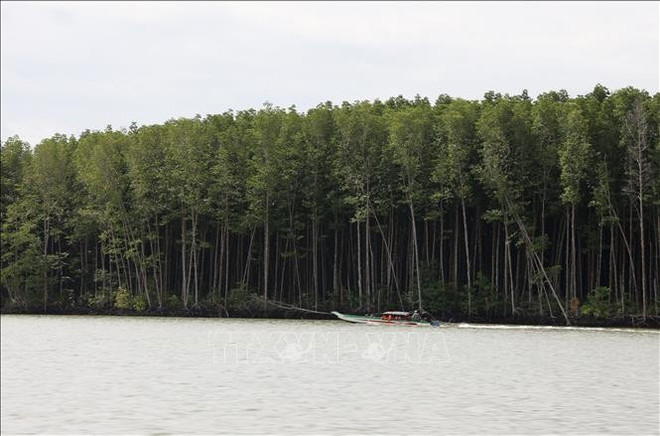With joint efforts from businesses, local authorities, communities, and travellers, the road to green tourism, though not lined with roses, may be the most rewarding path forward for Vietnam’s tourism future.
In today’s context, green transition is no longer a choice – it is a pressing necessity for Vietnam’s “smokeless industry” to develop sustainably, responsibly, and competitively on the global tourism map.
Sustainable tourism - Choice or obligation?
Back in 2018, the Vietnam Tourism Association (VITA) launched a campaign of reducing plastic waste in tourism activities. In 2019, green tourism became the official theme of the Vietnam International Travel Mart (VITM), built on four core pillars – plastic-free travel, non-motorised transport, community-based and agricultural tourism development, and destination clean-up campaigns.
VITA Chairman Vu The Binh said that the association has developed and issued the VITA Green criteria – a practical and measurable framework that allows businesses to self-assess and improve their sustainability efforts systematically.
However, the journey toward green transformation is far from smooth. According to Chairman of LuxGroup Dr Pham Ha, investing in energy-efficient equipment, waste treatment systems, and environmentally friendly materials is extremely costly. Small and medium-sized businesses, in particular, struggle to tap into the green tourism market due to high investment costs, long payback periods, and a lack of tax or credit incentives.
Ha underlined that to go green, businesses must do more than scratching the surface. They need to restructure internally, integrate sustainability into their business strategies, and inspire the entire system to act.
Despite these challenges, many businesses and localities are choosing the path of sustainability. Tra Que vegetable village in Hoi An city, recognised by the UN World Tourism Organisation as one of the “Best Tourism Villages in the World 2024”, exemplifies a commitment to environmental protection, cultural preservation, and livelihood improvement for local people.
Lux Travel DMC, a subsidiary of LuxGroup, has become the first Vietnamese company to earn the Travelife Certified label. From replacing plastic bottles with reusable ones and using fabric bags to installing energy-saving devices on its cruises, the company has consistently implemented green practices as part of its strategic vision.
In the Trang An eco-tourism area in Ninh Binh province, nearly all boat rowers are local residents, and plastic waste has been reduced by 60%. This highlights how green tourism can not only protect the environment but also generate livelihoods for local communities.
Patrick Haverman, Deputy Resident Representative of UNDP Vietnam, noted that the green transition must be integrated with comprehensive spatial planning. This includes the development of low-impact infrastructure, particularly in nature reserves and national parks, alongside effective solid and wastewater management.
The vision for a green destination should be about more than conservation. It must also rethink how visitors move around. Green transport doesn’t just protect the environment, it deepens the travel experience, thus enhancing a destination’s value, Haverman said.
A concrete example is the green mobility project being implemented by UNDP in Phu Yen province and Hue city, featuring "Green transport check-in and sharing points" in Tuy Hoa and Hon Yen. These hubs aim to raise community awareness and serve as replicable models.
Dr Nguyen Anh Tuan, Director of the Institute for Tourism Development Research, argued that Vietnam should actively promote responsible tourism investment, encourage the use of clean technology and renewable energy, and tighten control on so-called “green tourism” projects used to mask real estate speculation.
 The Can Gio mangrove forest contributes to protecting the living environment for residents in Ho Chi Minh City and neighbouring areas. (Photo: VNA)
The Can Gio mangrove forest contributes to protecting the living environment for residents in Ho Chi Minh City and neighbouring areas. (Photo: VNA)For sustainable development, he opined, it is essential to complete the legal and policy frameworks for green tourism – particularly in areas such as waste and wastewater management, environmental impact assessment, and green investment incentives through preferential loans and tax relief.
Urgent actions needed
Vu Quoc Tri, Secretary General of the VITA, stressed that tourism cannot be called “green” if plastic waste continues to overflow. He proposed a synchronised approach based on four pillars – green planning, efficient destination management, reduced plastic and carbon emissions, and nature-based tourism.
Prof. Dr Nguyen Van Dinh from the Institute of Tourism Economics also emphasised the importance of community-based tourism and the circular economy in the green transition. He advocated prioritising organic products, local handicrafts, and environmental education for both visitors and businesses.
Travellers in a boat tour in the Mekong Delta province of Tien Giang (Photo: VNA)
Tourism should embrace eco-friendly transport like bicycles and electric vehicles, along with water and energy-saving practices and renewable energy use at accommodation facilities, he recommended.
To make green tourism a reality, experts argue that Vietnam needs a national-level comprehensive strategy. This includes expanding green finance through support funds for technological innovation and green infrastructure development, and helping businesses access concessional credit. At the same time, a nationwide green communication campaign should promote responsible tourism and sustainable living habits through digital platforms and social media.
The State must play a central role in building a strong legal framework, monitoring compliance, and sanctioning environmental violations committed under the guise of tourism, Dinh stressed.
Experts agreed that while challenges to green transition in tourism are real, the potential is even greater. Vietnam is taking its first steady steps. With joint efforts from businesses, local authorities, communities, and travellers, the road to green tourism, though not lined with roses, may be the most rewarding path forward for Vietnam’s tourism future./.